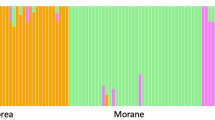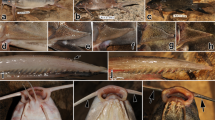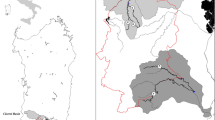Abstract
Elasmobranch species are among the most threatened marine fish, and sound biological data for many of them are lacking. In this context, the smooth-hounds (Mustelus spp., Triakidae, Carcharhiniformes) represent an intriguing genus, being characterized by unclear and sometimes contrasting diagnostic traits. Here, we present new insights into the identification of two closely related species, M. mustelus and M. punctulatus. The use of three different molecular markers on a dataset of 588 specimens highlighted a genetic distinction between the two species. However, whereas microsatellites provided unambiguous results in all the samples, the other two markers were not able to assign a fraction of the individuals (6.6% for cytochrome c oxidase subunit 1, 14.4% for Internal Transcribed Spacer 2), suggesting the occurrence of heteroplasmy and introgression due to past hybridisation events. The comparison between morphological traits, previously suggested as diagnostic for species identification, and genetic identification, enabled validation of the most reliable and practical morphological traits for species identification. The shape of the dermal denticles represents the most reliable trait, but its use during fieldwork may be impractical. The black spots on body sides were present almost exclusively in M. punctulatus, allowing its identification; however, their absence is not diagnostic for M. mustelus. The distance of the nostrils and the shape of the mouth are useful to distinguish the two species during fieldwork. Our results will allow an accurate identification of the two species leading to the collection of reliable data on their distribution, life history traits, exploitation and status of conservation.







Similar content being viewed by others
References
Alquezar DE, Hemmerter S, Cooper RD, Beebe NW (2010) Incomplete concerted evolution and reproductive isolation at the rDNA locus uncovers nine cryptic species within Anopheles longirostris from Papua New Guinea. BMC Evol Biol 10:392. doi:10.1186/1471-2148-10-392
Amos W, Hoffman JI, Frodsham A, Zhang L, Best S, Hill AVS (2007) Automated binning of microsatellite alleles: problems and solutions. Mol Ecol Notes 7:10–14. doi:10.1111/j.1471-8286.2006.01560.x
Anderson MJ, Gorley RN, Clarke KR (2008) PERMANOVA+ for PRIMER: guide to software and statistical methods. PRIMER-E, Plymouth
Baino R, Serena F, Ragonese S, Rey J, Rinelli P (2001) Catch composition and abundance of elasmobranchs based on the MEDITS program. Rapp Comm Int Mer Médit 36:234
Barausse A, Correale V, Curkovic A, Finotto L, Riginella E, Visentin E, Mazzoldi C (2014) The role of fisheries and the environment in driving the decline of elasmobranchs in the northern Adriatic Sea. ICES J Mar Sci 71:1593–1603. doi:10.1093/icesjms/fst222
Benjamini Y, Hochberg Y (1995) Controlling the false discovery rate: a practical and powerful approach to multiple testing. J R Stat Soc B 57:289–300
Branstetter S (1984) Triakidae. In: Whitehead PJP, Bauchot ML, Hureau JC, Nielsen J, Tortonese E (eds) Fishes of the north-eastern Atlantic and the Mediterranean, vol 1. UNESCO, Paris, pp 117–121
Compagno LJV (1984) FAO species catalogue. Sharks of the world. An annotated and illustrated catalogue of the shark species known to date. Part 2. Carcharhiniformes. Vol. 4. FAO Fisheries Synopsis No. 125. FAO, Rome, pp 251–655
Dulvy NK, Metcalfe JD, Glanville J, Pawson MG, Reynolds JD (2000) Fishery stability, local extinctions, and shifts in community structure in skates. Conserv Biol 14:283–293. doi:10.1046/j.1523-1739.2000.98540.x
Dulvy NK, Baum JK, Clarke S et al (2008) You can swim but you can’t hide: the global status and conservation of oceanic pelagic sharks and rays. Aquat Conserv 18:459–482. doi:10.1002/aqc.975
Dulvy NK, Fowler SL, Musick JA et al (2014) Extinction risk and conservation of the world’s sharks and rays. elife 3:e00590. doi:10.7554/eLife.00590
Ebert DA, Stehmann MFW (2013) Sharks, batoids, and chimaeras of the North Atlantic FAO Species Catalogue for Fishery Purposes. No. 7. FAO, Rome
Evanno G, Regnaut S, Goudet J (2005) Detecting the number of clusters of individuals using the software STRUCTURE: a simulation study. Ecology 14:2611–2620. doi:10.1111/j.1365-294X.2005.02553.x
Excoffier L, Lischer HEL (2010) Arlequin suite ver 3.5: a new series of programs to perform population genetics analyses under Linux and Windows. Mol Ecol Resour 10:564–567. doi:10.1111/j.1755-0998.2010.02847.x
Falush D, Stephens M, Pritchard JK (2003) Inference of population structure using multilocus genotype data: linked loci and correlated allele frequencies. Genetics 164:1567–1587
Farrell ED (2010) The life-history and population biology of the starry smooth-hound, Mustelus asterias in the Northeast Atlantic Ocean. PhD thesis, University College Dublin
Farrell ED, Clarke MW, Mariani S (2009) A simple genetic identification method for Northeast Atlantic smoothhound sharks (Mustelus spp.) ICES J Mar Sci 66:561–565. doi:10.1093/icesjms/fsn218
Fischer W, Bauchot ML, Schneider M (1987) Fiches FAO d’identification des espèces pour les besoins de la pêche. (Révision 1). Méditerranée et mer Noire. Zone de pêche 37. Volume II: Vertébrés, pp. 761–1530. Publication préparée par la FAO, résultat d’un accord entre la FAO et la Commission des Communautés Européennes (Projet GCP/INT/422/EEC) financée conjointement par ces deux organisations. FAO, Rome
Fortuna CM, Vallini C, Filidei E Jr et al (2010) By-catch of cetaceans and other species of conservation concern during pair trawl fishing operations in the Adriatic Sea (Italy). Chem Ecol 26:65–76. doi:10.1080/02757541003627662
Gong L, Shi W, Yang M, Si L, Kong X (2016) Non-concerted evolution in ribosomal ITS2 sequence in Cynoglossus zanzibarensis (Pleuronectiformes: Cynoglossidae). Biochem Syst Ecol 66:181–187. doi:10.1016/j.bse.2016.04.002
Heemstra PC (1973) A revision of the shark genus Mustelus Squaliformes: Carcharhinidae. PhD thesis, University of Miami
Hillis DM, Moritz C, Porter CA, Baker RJ (1991) Evidence for biased gene conversion in concerted evolution of ribosomal DNA. Science 251:308–310. doi:10.1126/science.1987647
Hubisz M, Falush D, Stephens M, Pritchard JK (2009) Inferring weak population structure with the assistance of sample group information. Mol Ecol Resour 9:1322–1332. doi:10.1111/j.1755-0998.2009.02591.x
Jardas I (1996) Jadranska ihtiofauna. [Ichthyofauna of the Adriatic Sea] Školska knjiga, Zagreb
Jardas I, Pallaoro A, Vrgoč N, Jukić-Peladić S, Dadić V (2008) Red book of sea fishes of Croatia. State Institute for Nature Protection, Ministry of Culture, Republic of Croatia
López JA, Ryburn JA, Fedrigo O, Naylor GJ (2006) Phylogeny of sharks of the family Triakidae (Carcharhiniformes) and its implications for the evolution of carcharhiniform placental viviparity. Mol Phylogenet Evol 40:50–60. doi:10.1016/j.ympev.2006.02.011
Marino IAM, Riginella E, Cariani A, Tinti F, Farrell ED, Mazzoldi C, Zane L (2015a) New molecular tools for the identification of 2 endangered smooth-hound sharks, Mustelus mustelus and Mustelus punctulatus. J Hered 106:123–130. doi:10.1093/jhered/esu064
Marino IAM, Riginella E, Gristina M, Rasotto MB, Zane L, Mazzoldi C (2015b) Multiple paternity and hybridization in two smooth-hound sharks. Sci Rep 5:12919. doi:10.1038/srep12919
Mazzoldi C, Sambo A, Riginella E (2014) The Clodia database: a long time series of fishery data from the Adriatic Sea. Sci Data 1:140018. doi:10.1038/sdata.2014.18
Morgan JAT, Harry AV, Welch DJ et al (2012) Detection of interspecies hybridisation in Chondrichthyes: hybrids and hybrid offspring between Australian (Carcharhinus tilstoni) and common (C. limbatus) blacktip shark found in an Australian fishery. Conserv Genet 13:455–463. doi:10.1007/s10592-011-0298-6
Nieto A, Ralph GM, Comeros-Raynal MT et al (2015) European red List of marine fishes. Publications Office of the European Union, Luxembourg
Patwary MU, Kenchington EL, Bird CJ, Zouros E (1994) The use of random amplified polymorphic DNA markers in genetic studies of the sea scallop Placopecten magellanicus (GMELIN, 1791). J Shellfish Res 13:547–553
Pritchard JK, Stephens M, Donnelly P (2000) Inference of population structure using multilocus genotype data. Genetics 155:945–959
Quignard JP, Capapé C (1972) Note sur les espèces méditerranéennes du genre Mustelus (Selachii, Galeoidea, Triakidae). Rev Trav Inst Pêches Marit 36:15–29
Rasband WS (1997–2016) ImageJ. U. S. National Institutes of Health. Bethesda, Maryland, USA. http://imagej.nih.gov/ij/
Raymond M, Rousset F (1995) GENEPOP (version 1.2): population genetics software for exact tests and ecumenicism. J Hered 86:248–249
Rondinini C, Battistoni A, Peronace V, Teofili C (2013) Lista Rossa IUCN dei Vertebrati Italiani. Comitato Italiano IUCN e Ministero dell’Ambiente e della Tutela del Territorio e del Mare, Roma
Rousset F (2008) GENEPOP’007: a complete reimplementation of the GENEPOP software for Windows and Linux. Mol Ecol Resour 8:103–106. doi:10.1111/j.1471-8286.2007.01931.x
Serena F (2005) Field identification guide to the sharks and rays of the Mediterranean and Black Sea. FAO Species Identification Guide for Fishery Purposes. FAO, Rome
Serena F, Mancusi C, Haka F, Morey G, Schembri T (2009a) Mustelus punctulatus. The IUCN Red List of Threatened Species 2009: e.T161485A5434647. http://dx.doi.org/10.2305/IUCN.UK.2009-2.RLTS.T161485A5434647.en. Downloaded on 24 July 2016
Serena F, Mancusi C, Clò S, Ellis J, Valenti SV (2009b) Mustelus mustelus. The IUCN Red List of Threatened Species 2009: e.T39358A10214694. http://dx.doi.org/10.2305/IUCN.UK.2009-2.RLTS.T39358A10214694.en. Downloaded on 06 March 2017
Smith GP (1974) Unequal crossover and the evolution of multigene families. Cold Spring Harb Symp Quant Biol 38:507–513. doi:10.1101/SQB.1974.038.01.055
Weir BS, Cockerham CC (1984) Estimating F-statistics for the analysis of population structure. Evolution 38:1358–1370. doi:10.2307/2408641
Worm B, Davis B, Kettemer L et al (2013) Global catches, exploitation rates, and rebuilding options for sharks. Mar Policy 40:194–204. doi:10.1016/j.marpol.2012.12.034
Acknowledgements
We are grateful to E. Riginella, V. Correale, A. Vrbatović, G. Giusto, P. Rizzo, S. Gangitano, and G. Sinacori for sample collection in Chioggia and Mazara del Vallo. We also thank Fausto Tinti and Alessia Cariani for their useful inputs and scientific support, and R. Castilho and an anonymous referee for their suggestions.
Author information
Authors and Affiliations
Corresponding author
Ethics declarations
Funding
This project was financially supported by the CLODIA project, funded by the Veneto Region (Italy) Law 15/2007 (DGR n. 4069), and by the Athenaeum Projects CPDA110183 and CPDA148387, funded by the University of Padova. Samples in Mazara del Vallo were collected in the frame of the Italian Flagship programme Ritmare and the EU Data Collection Framework (EU-DCF) carried out in the FAO-GFCM Geographical Sub-Area 16 (South of Sicily).
IAMM was supported by a University of Padova post-doc grant (CPDR123580), and LF by the project “Inventario della biodiversità marina siciliana e sviluppo di tecniche di monitoraggio utili alla gestione di specie ed habitat protetti.” (PO FESR 20072013, linea di intervento 3.2.1.2) from Sicily Region (Italy).
Conflict of interest
The authors declare that they have no conflict of interest.
Ethical approval
All the analyses were carried out on dead specimens caught during normal fishing activity and, therefore, no approval from the local ethics committee was necessary.
Additional information
Communicated by R. Thiel
Rights and permissions
About this article
Cite this article
Marino, I.A.M., Finotto, L., Colloca, F. et al. Resolving the ambiguities in the identification of two smooth-hound sharks (Mustelus mustelus and Mustelus punctulatus) using genetics and morphology. Mar Biodiv 48, 1551–1562 (2018). https://doi.org/10.1007/s12526-017-0701-8
Received:
Revised:
Accepted:
Published:
Issue Date:
DOI: https://doi.org/10.1007/s12526-017-0701-8




